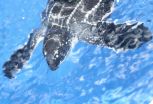(Press-News.org) MADISON, Wis. — Bigger is better, if you're a leatherback sea turtle.
For the first time, researchers at the University of Wisconsin-Madison, Florida Atlantic University (FAU), and the National Oceanic and Atmospheric Administration (NOAA) have measured the forces that act on a swimming animal and the energy the animal must expend to move through the water.
A surprising finding: Longer, slender turtles are less efficient swimmers than more rotund turtles, which get better stroke for their buck.
By taking these measurements, the research team — led by UW-Madison's Warren Porter — built models of swimming turtles and, in doing so, have enabled others to "compute the energetics, behavior and distributions of a species anywhere on Earth now or in the future," says Porter, a professor of zoology. The findings are published today in the journal PLOS One.
As climate change shifts the habitable ranges of both land and sea animals, and as scientists and others try to reconstruct ancient habitats of long-ago species, the ability to assess and predict an animal's physical interactions with the environment is key. The researchers see their work as instrumental for everyone from land managers to paleoecologists, students and conservationists.
"If you've got mechanistic models, then whatever kind of scenarios you want to run for the environment, you can run these models and have a lot of confidence that they're giving you good numbers," says Porter, who previously developed a model for land animals.
But getting there wasn't easy.
Several labs have tried to model the movements of animals in water but "swimming animals are very, very difficult to measure experimentally," Porter says. "It's very difficult to get drag and thrust."
No one before had been able to measure the fluid dynamics of a swimming creature, or the energetics required to perform the work of moving through water. This allows scientists to measure critical aspects of biology, such as how much food an animal must eat to survive.
It was serendipity that connected Porter and the lead author of the study, Peter Dudley, a former graduate student in Porter's lab, to the scientists at FAU who would eventually help solve the problem.
Jeanette Wyneken, FAU professor of biological sciences, had developed methods to keep newborn leatherback sea turtles in the lab for study. She and her former students created a tether system that allows the turtles to swim freely while also staying safe; the turtles don't recognize barriers and can easily injure themselves in their enclosures.
Porter, Dudley and Todd Jones — Wyneken's former graduate student and now a NOAA physiologist — tethered the turtles to instruments that allowed them to measure the force they produced while swimming. They also measured the oxygen the turtles consumed (a direct measure of their metabolism) and the heat they exchanged with the environment. All the while, the scientists took video of the tiny turtles.
Then the team recreated a virtual environment with a swimming turtle, to see if they could predict how much energy the turtle was using. Dudley, whose background is in engineering, says Porter uses "on-the-ground" engineering tools in his lab.
They scaled this up to model the three-dimensional motion of swimming juvenile leatherback sea turtles , to find power and heat transfer rates during the larger animal's flipper strokes.
It was here, by playing with the parameters of their virtual reality turtles, that the researchers learned husky turtles were better swimmers than their leaner counterparts.
"That was a surprise and I thought it was a mistake when I originally did it," says Dudley, who eventually learned that the flippers of thinner turtles come closer together at the bottom of their stroke than those of larger turtles, causing them to lose power.
It is that question — how does body size interact with the physical environment to constrain evolutionary design — that lies at the crux of the study's findings.
"We can literally design animals now and ask how are they going to function, just like a car or a rocket ship," says Porter. He is currently engaged in a UW-Madison initiative called Climate Quest, a competition to solve climate-change problems, and is putting this expertise to use.
In his project, he is assessing the impact of climate change on milk production in dairy cows in order to "select for cows 50 or 100 years from now," to improve production both now and in the face of a different planet.
"Now that we have (models) for both marine and terrestrial environments, we can answer those types of questions and get back to the big mass extinctions and get some insights into how did animals live before and after those extinctions," Porter says. "Why were the animals that survived able to survive?"
The researchers collaborated with Riccardo Bonazza, a UW-Madison professor of engineering physics, to develop their swimming turtle models. And it was the art department, says Porter, that enabled them to create a virtual swimming turtle.
"When you're looking at a problem, the more different ways you can look at it, the more different perspectives you can get on it, the more ideas you can have on how to deal with it and ... on different directions you can go," says Porter.
INFORMATION:
The study was funded in part by the UW Foundation and a Disney Worldwide Conservation Fund grant.
CONTACT: Warren Porter, 608-262-1719, wpporter@wisc.edu; Peter Dudley, P.N.D.PhD@gmail.com
Heparin, the life saving blood thinner used in major surgeries and treatment of heart diseases, is a complicated drug but a research team from the University of British Columbia has set out to make its use a lot safer by developing a universal antidote.
Heparin's blood thinning action often requires an antidote to reverse its effect before serious bleeding issues arise especially in the case of major surgical procedures.
Finding an approved drug to reverse the blood thinning effect of heparin is complicated because there are about a dozen approved heparin products ...
Maggot infestations, rotting carcasses, unidentifiable gunk in the kitchen sink – how much your brain responds to disgusting images could predict whether you are liberal or conservative.
In a study to be published in an upcoming issue of Current Biology, an international team of scientists led by Virginia Tech reports that the strength of a person's reaction to repulsive images can forecast their political ideology.
"Disgusting images generate neural responses that are highly predictive of political orientation even when those neural responses don't correspond ...
Sleep apnea may affect your ability to form new spatial memories, such as remembering where you parked your car, new research led by NYU Langone Medical Center sleep specialists suggests.
The study, published online Oct. 29 in Journal of Neuroscience, demonstrates through the playing of a specific video game that disruption of rapid eye movement (REM) sleep as a consequence of sleep apnea impairs spatial memory in humans even when other sleep stages are intact.
Spatial memory is utilized for everyday tasks, such as remembering the location of a favorite restaurant, ...
Wind shear has kicked in and has been pushing clouds and showers away from Tropical Cyclone Nilofar's center. NASA's Aqua satellite captured an image that showed the effects of the shear on Oct. 29.
The Moderate Resolution Imaging Spectroradiometer aboard NASA's Aqua satellite captured an image of Tropical Cyclone Nilofar on Oct. 29 at 09:00 UTC (5 a.m. EDT). Tropical Cyclone Nilofar is moving through the Arabian Sea. The image shows that clouds were being pushed to the northeast of the center of the storm, from strong southwesterly wind shear.
On Oct. 29 at 1500 UTC ...
In the largest study of its kind to date, researchers have used DNA sequencing to uncover dozens of genes that heighten the risk for autism. Joseph Buxbaum, Ph.D., Icahn School of Medicine at Mount Sinai, New York City, Mark Daly, Ph.D., Broad Institute of Harvard and MIT, and their colleagues examined more than 14,000 DNA samples from affected children, parents and unrelated people. They identified changes in 107 genes that are likely to contribute to the risk for autism spectrum disorder (ASD) – a jump from the nine genes implicated in earlier studies using these ...
Small differences in as many as a thousand genes contribute to risk for autism, according to a study led by Mount Sinai researchers and the Autism Sequencing Consortium (ASC), and published today in the journal Nature.
The new study examined data on several types of rare, genetic differences in more than 14,000 DNA samples from parents, affected children, and unrelated individuals – by far the largest number to date – to dramatically expand the list of genes identified with autism spectrum disorder (ASD).
Most of the genes that contribute to autism remain ...
A research group led by Anne Dutrey from the Laboratory of Astrophysics of Bordeaux, France, and the National Centre for Scientific Research (CNRS) observed the distribution of dust and gas in a binary star system called GG Tau-A. It was recently discovered that one of GG Tau-A's components is itself a double star. This object is only a few million years old and lies approximately 460 light-years from Earth in the constellation Taurus.
Like a wheel in a wheel, GG Tau-A contains a large, outer disk encircling the entire system as well as an inner disk around the main central ...
Mouse lemurs can live at least eight years in the wild – twice as long as some previous estimates, a long-term longitudinal study finds.
PLOS ONE published the research on brown mouse lemurs (Microcebus rufus) led in Madagascar by biologist Sarah Zohdy, a post-doctoral fellow in Emory University's Department of Environmental Sciences and the Rollins School of Public Health. Zohdy conducted the research while she was a doctoral student at the University of Helsinki.
"It's surprising that these tiny, mouse-sized primates, living in a jungle full of predators that ...
A team led by the Lawrence Livermore scientists has created a new kind of ion channel based on short carbon nanotubes, which can be inserted into synthetic bilayers and live cell membranes to form tiny pores that transport water, protons, small ions and DNA.
These carbon nanotube "porins" have significant implications for future health care and bioengineering applications. Nanotube porins eventually could be used to deliver drugs to the body, serve as a foundation of novel biosensors and DNA sequencing applications, and be used as components of synthetic cells.
Researchers ...
A study led by investigators from Massachusetts General Hospital and the Perelman School of Medicine at the University of Pennsylvania has identified a potential target for therapies to treat cocaine addiction. In their study receiving advance online publication in Molecular Psychiatry, the investigators find evidence that changing one amino acid in a subunit of an important receptor protein alters whether cocaine-experienced animals will resume drug seeking after a period of cocaine abstinence. Increasing expression of the enzyme responsible for that change within the ...



